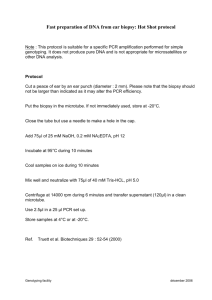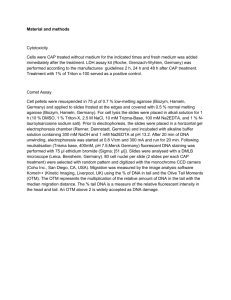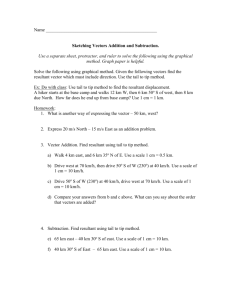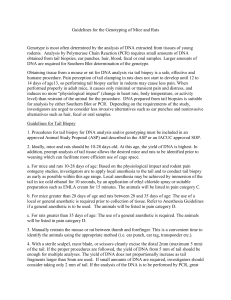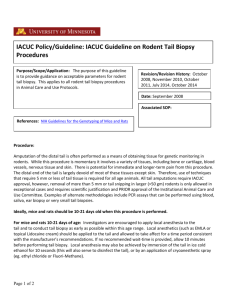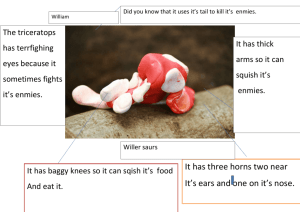USC Department of Animal Resources
advertisement
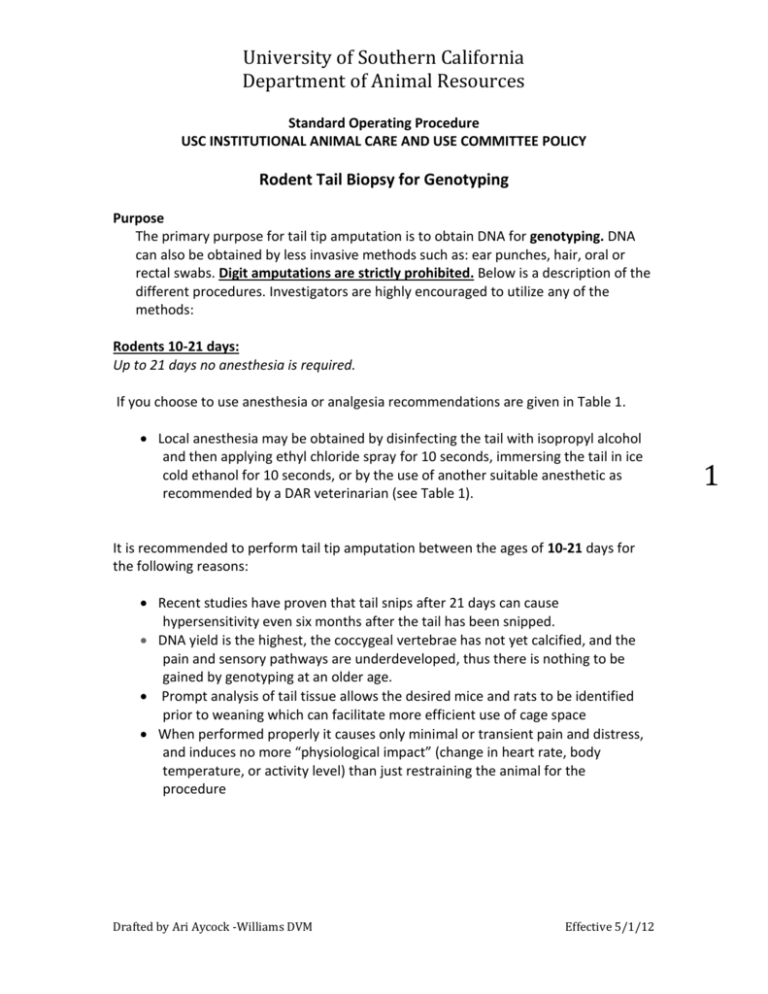
University of Southern California Department of Animal Resources Standard Operating Procedure USC INSTITUTIONAL ANIMAL CARE AND USE COMMITTEE POLICY Rodent Tail Biopsy for Genotyping Purpose The primary purpose for tail tip amputation is to obtain DNA for genotyping. DNA can also be obtained by less invasive methods such as: ear punches, hair, oral or rectal swabs. Digit amputations are strictly prohibited. Below is a description of the different procedures. Investigators are highly encouraged to utilize any of the methods: Rodents 10-21 days: Up to 21 days no anesthesia is required. If you choose to use anesthesia or analgesia recommendations are given in Table 1. Local anesthesia may be obtained by disinfecting the tail with isopropyl alcohol and then applying ethyl chloride spray for 10 seconds, immersing the tail in ice cold ethanol for 10 seconds, or by the use of another suitable anesthetic as recommended by a DAR veterinarian (see Table 1). It is recommended to perform tail tip amputation between the ages of 10-21 days for the following reasons: Recent studies have proven that tail snips after 21 days can cause hypersensitivity even six months after the tail has been snipped. DNA yield is the highest, the coccygeal vertebrae has not yet calcified, and the pain and sensory pathways are underdeveloped, thus there is nothing to be gained by genotyping at an older age. Prompt analysis of tail tissue allows the desired mice and rats to be identified prior to weaning which can facilitate more efficient use of cage space When performed properly it causes only minimal or transient pain and distress, and induces no more “physiological impact” (change in heart rate, body temperature, or activity level) than just restraining the animal for the procedure Drafted by Ari Aycock -Williams DVM Effective 5/1/12 1 University of Southern California Department of Animal Resources Rodents older than 21 days: If the tail biopsy can’t be performed before 21 days, then it is required that a topical anesthetic, general anesthetic or analgesic be administered to the rodent prior to cutting the tip of the tail. Procedure The proper procedure for tail tip amputation is as follows: 1. Always use clean gloves and a sterile sharp scalpel, scissors or razor blade for each animal. 2. Disinfect the distal tip of the tail with alcohol (do not use iodine solutions because they may interfere with DNA analysis.) 3. Give the appropriate pain medications ( see Table 1) 4. Gently restrain the mouse and make one clean cut through the tail. 5. A maximum of 5mm of the tail may be amputated. The amount of DNA obtained does not proportionally increase with samples of over 5 mm length and in most cases a 2 mm tail biopsy is more than adequate. 6. If the proper procedures are followed, the yield of DNA from 5 mm of tail should exceed 50 micrograms, enough for multiple analyses. It is good practice to divide the tissue into several pieces after collection, label and freeze the extra samples at -20C in case you have to verify your samples. 7. Hemorrhage must be controlled with the use of silver nitrate sticks, applied pressure, or Kwik Stop®. Consult a DAR Veterinarian if problems with hemostasis are expected or encountered (e.g. genetically modified mice with clotting disorders). 8. Place the animal in a clean dry cage once hemostasis has been achieved. Observe the animal to make sure bleeding has stopped since the presence of blood will increase aggression between cage mates. Avoid co-housing sedated and active animals. 9. For use on multiple animals, all instruments (scalpel, scissors, or razor blades) must be sterilized) prior to and between use on different animals.. Alcohol is not a very efficient disinfectant (NRC, 2011) therefore the use of 70% Isopropanol /Ethanol is not allowed as an instrument disinfectant. If a scalpel or razor blade is used, also disinfect the work surface on which the tail is placed between animals. Recommendations for sterilization are given in Table 2. Alternative to disinfection is the use of disposable sterile instruments and discard them after each animal. 10. Tail tip amputation may NOT be used as the sole purpose to collect blood. However, blood can be collected from the tail tip at the time of genotyping. Drafted by Ari Aycock -Williams DVM Effective 5/1/12 2 University of Southern California Department of Animal Resources Indication for administering pain medication: After 21 days, the tail vertebrae have calcified and pain can be felt by the animal long after the procedure has been completed which can also interfere with research. Behavioral, physiological, and electroencephalographic evidence suggests that the ability to perceive pain develops gradually and begins as early as postnatal day 12 in mice; responses to pain increase with age (Diesch et al, 2009 and Hankenson et al. 2008). The following options are provided for pain management: Table 1. Pain Medications Options Required before biopsy Option 1 Buprenorphine (0.01-0.05 mg/kg) SC once 10 mins before biopsy Option 2 NSAID such as Meloxicam (0.02-0.5 mg/kg PO) or Carprofen (4-5 mg/kg SC), Ketoprofen (5 m/kg SC) before biopsy Option 3 Ethyl Chloride spray applied for 10 seconds Option 4 General Anesthetic: Isoflurane Recommended after biopsy NSAID AND/OR Marcaine® Buprenorphine AND/OR Marcaine® 3 Buprenorphine OR NSAID AND/OR Marcaine® Buprenorphine OR NSAID AND/OR Marcaine® *Other anesthetic agents may be used if approved by the IACUC. Marcaine®(Bupivicaine) -0.5% 1mL/kg is applied to the amputated surface of the tail with a cotton tip applicator. Isoflurane can be administered using the following methods: 1) a bell jar; 2) a cotton ball saturated with the agent can be placed inside a tissue cassette and then the cassette can be placed inside a clear plastic bag containing the mouse; 3) through a precision vaporizer attached to an anesthetic machine. Drafted by Ari Aycock -Williams DVM Effective 5/1/12 University of Southern California Department of Animal Resources Table 2. Sterilization Recommendations: Sterilizer Contact Time Autoclave 20-90 minutes depending on weight Hot Bead Sterilizer Ethylene Oxide Cidex™ Hydrogen Peroxide 15 seconds >3 hours 5 minutes 10 minutes Alternatives to Tail Tip Amputation Ear Punching: Ear punching does not require anesthesia in rodents when performed by a skilled individual. Ear punches are generally obtained at approximately 15-17 days of age, after the ear has “thinned.” Several tissue samples can be obtained using a commercially available rodent ear-punch. Consult a DAR Veterinarian regarding how to properly perform this method. The ear punch procedure should be performed using clean gloves and a sterile ear-punch. Manually restrain the animal and place the punch device on the pinna of the ear (external ear) in a location where you want to mark the animal for identification. Make sure that you do not include the skin of the shoulder! Press firmly to punch a circular hole through the ear. As you remove the punch, be careful not to rip the delicate membrane of the pinna. Gently separate the ear from the device and remove the sample for tissue analysis. Bleeding after ear punching is uncommon and the animal can be released directly into the cage. If the analysis of the DNA is to be performed by PCR, great care should be taken to remove all tissue from the ear punch after each animal. Sterilizing the ear punch between animals using a hot-bead sterilizer will also minimize the potential of DNA cross contamination. Hair Bulb Sampling: The use of hair bulbs in human forensic medicine is common and sufficient DNA can be extracted from a single hair bulb to perform genetic screening by PCR. The standard protocol for identification of transgenic animals is based on tissue samples and preparation of chromosomal DNA including proteinase K digestion and phenol/chloroform extraction. The hair bulb procedure is much simpler and faster method using alkaline lysis followed by Drafted by Ari Aycock -Williams DVM Effective 5/1/12 4 University of Southern California Department of Animal Resources PCR (Schmitteckert. et.al). Extension of these common procedures and protocols to the genetic identification of rodents reduces both the animal pain and distress and the technical effort required in comparison to the standard tail biopsy procedure. The actual sample collection procedure requires the manual restraint of the animal and the removal of a tuft of hair from the ventral body using forceps. While there is no necessity for sterile instruments, the use of a new set of forceps for each animal minimizes the potential of cross contamination between animals. Hair bulb sampling can be performed at any age and does not require any anesthesia or analgesia. There are a number of commercially available DNA extraction kits for hair bulb samples. Fecal Sampling: Feces contain sloughed intestinal epithelial cells which may serve as a source of DNA for genetic analysis. Stool samples can be easily collected from the cage of singly housed rodents or a fresh sample can be obtained directly from the animal (rodents routinely defecate when gently handled). The genetic analysis procedures have been described by Broome, et.al. Although infrequently used, genetic analysis using feces is a completely non-invasive procedure with the potential of greatly reducing the effort required to collect samples for analysis. Saliva Sampling: Saliva sampling is routinely used for genetic analysis in humans to determine paternity. A small amount of saliva contains sufficient oral epithelial cells to permit PCR analysis. Unlike the human situation where swabs are used to collect the epithelial cells, the collection technique in rodents involves the washing of the oral cavity of weanling animals using a plastic pipette tip (Irwin, et.al.) Note: tail biopsy/ tail amputation (“tail snip” or “tail tip”) must be described in the USC protocol/amendment and any proposed deviations from these guidelines require additional scientific justification Example wording for an Animal Synopsis Form (>21 days old): Tail biopsies are performed on mice days >21 days of age. The animal will be manually restrained, the tail tip cleaned with alcohol. The following pain medication will be given/ the tail will be sprayed with ethyl chloride for 10 seconds/ the animal will be administered Isoflurane through ________ (choose Drafted by Ari Aycock -Williams DVM Effective 5/1/12 5 University of Southern California Department of Animal Resources one). The tail biopsy procedure will be performed using clean gloves and a sterile sharp scalpel, scissors, or razor blade (choose one). The sample will be as small as possible and will not exceed 5mm in length. One clean cut will be made through the tail. Any bleeding will be controlled with pressure and sterile gauze followed by the use of silver nitrate, or styptic powder. Instruments will be sterilized with _______between animals.____________ will be given to all animals after the procedure to relieve pain and/ or Bupivicaine will be applied to the cut surface. Example wording for an Animal Synopsis Form (<21 days old): Tail biopsies are performed on mice <21 days of age. The animal will be manually restrained, the tail tip cleaned with alcohol. The tail biopsy procedure will be performed using clean gloves and a sterile sharp scalpel, scissors, or razor blade (choose one). The sample will be as small as possible and will not exceed 5mm in length. One clean cut will be made through the tail. Any bleeding will be controlled with pressure and sterile gauze followed by the use of silver nitrate, or styptic powder. Instruments will be sterilized with _______between animals. This policy for obtaining tail biopsies for genotyping is in accordance with the NIH guidelines for Genotyping Mice and Rats and the Guide for the Care and Use of Laboratory Animals. References 1. Brown University: http://research.brown.edu/rschadmin/Mouse%20Tail%20Biopsy%20Policy%20%20FINAL.doc 2. Cinelli P., et.al. Comparative Analysis and Physiological Impact of Different Tissue Biopsy Methodologies Used for the Genotyping of Laboratory Mice. Lab Animals 2007; 41: 174-184. 3. Guidelines for the Genotyping of Mice and Rats, ARAC Guidelines, Office of Animal Care and Use, National Institutes of Health, Revised 9/12/07(http://oacu.od.nih.gov/ARAC/documents/Rodent_Genotyping.pdf) 4. Hankenson CF, Garzel LM, Fischer DD, Nolan B, Hankenson KD. 2008. Mice (Mus musculus): Vertebral Ossification, DNA Quantity, and Acute Behavioral Responses. Journal of the American Association of 56Laboratory Animal Science. Nov 47(6):10-18. Drafted by Ari Aycock -Williams DVM Effective 5/1/12 6 University of Southern California Department of Animal Resources 5. Indiana University School of Medicine :http://www.iupui.edu/~somiacuc/worddoc/Tail%20snip%20guidelines%20Feb% 2003.doc 6. Meldgaard M, Bollen PJA, Finsen B. Non-invasive method for sampling and extraction of mouse DNA for PCR. Laboratory Animals 2004; 38:413-417. 7. University of Kentucky: www.rgs.uky.edu/dlar/documents/GeneticIdentification.doc 8. http://research.uthscsa.edu/iacuc/identification.shtml 9. www.research.fsu.edu/acuc/Policies.../Guidelines-Tail%20Biopsy.pdf 10. http://www.upenn.edu/regulatoryaffairs/Documents/iacuc/guidelines/iacuc guideline-rodentgenotypingmethods.pdf 11. http://louisville.edu/research/iacuc/policies/24%20Tissue%20Harvesting% 20for%20Genotyping.pdf 12. http://www.research.buffalo.edu/laf/resources/sop/2A9.pdf 13. http://www.cfsph.iastate.edu/BRM/resources/Disinfectants/Disinfection101 Feb2005.pdf 14. http://www.cdc.gov/hicpac/Disinfection_Sterilization/2_approach.html 15. http://www.aaalac.org/publications/Connection/Using_Alcohol_Disinfectant .pdf 16. The Guide for the Care and Use of Laboratory Animals: Eighth Edition, 2011. National Research Council of the National Academies. Drafted by Ari Aycock -Williams DVM Effective 5/1/12 7
